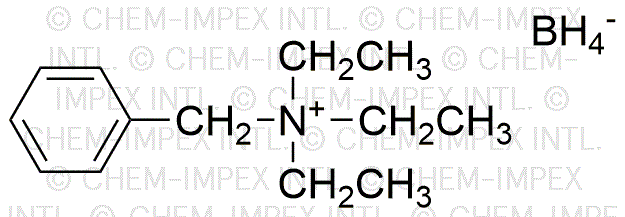Benzyltriethylammonium borohydride is widely utilized in research focused on:
- Organic Synthesis: This compound serves as a powerful reducing agent in organic chemistry, facilitating the reduction of various functional groups, which is essential for synthesizing complex organic molecules.
- Catalysis: It plays a significant role in catalytic processes, particularly in the formation of carbon-carbon bonds, making it valuable in the pharmaceutical and agrochemical industries for developing new compounds.
- Polymer Chemistry: Researchers use it to modify and enhance the properties of polymers, leading to materials with improved strength, flexibility, and thermal stability, which are crucial in manufacturing and packaging industries.
- Nanotechnology: The compound is applied in the synthesis of nanoparticles, which are used in various applications, including drug delivery systems and advanced materials, providing unique properties due to their small size.
- Environmental Chemistry: It is also explored for its potential in green chemistry applications, helping to reduce waste and improve the efficiency of chemical processes, aligning with sustainable practices in industry.
General Information
Properties
Safety and Regulations
Applications
Benzyltriethylammonium borohydride is widely utilized in research focused on:
- Organic Synthesis: This compound serves as a powerful reducing agent in organic chemistry, facilitating the reduction of various functional groups, which is essential for synthesizing complex organic molecules.
- Catalysis: It plays a significant role in catalytic processes, particularly in the formation of carbon-carbon bonds, making it valuable in the pharmaceutical and agrochemical industries for developing new compounds.
- Polymer Chemistry: Researchers use it to modify and enhance the properties of polymers, leading to materials with improved strength, flexibility, and thermal stability, which are crucial in manufacturing and packaging industries.
- Nanotechnology: The compound is applied in the synthesis of nanoparticles, which are used in various applications, including drug delivery systems and advanced materials, providing unique properties due to their small size.
- Environmental Chemistry: It is also explored for its potential in green chemistry applications, helping to reduce waste and improve the efficiency of chemical processes, aligning with sustainable practices in industry.
Documents
Safety Data Sheets (SDS)
The SDS provides comprehensive safety information on handling, storage, and disposal of the product.
Product Specification (PS)
The PS provides a comprehensive breakdown of the product’s properties, including chemical composition, physical state, purity, and storage requirements. It also details acceptable quality ranges and the product's intended applications.
Certificates of Analysis (COA)
Search for Certificates of Analysis (COA) by entering the products Lot Number. Lot and Batch Numbers can be found on a product’s label following the words ‘Lot’ or ‘Batch’.
*Catalog Number
*Lot Number
Certificates Of Origin (COO)
This COO confirms the country where the product was manufactured, and also details the materials and components used in it and whether it is derived from natural, synthetic, or other specific sources. This certificate may be required for customs, trade, and regulatory compliance.
*Catalog Number
*Lot Number
Safety Data Sheets (SDS)
The SDS provides comprehensive safety information on handling, storage, and disposal of the product.
DownloadProduct Specification (PS)
The PS provides a comprehensive breakdown of the product’s properties, including chemical composition, physical state, purity, and storage requirements. It also details acceptable quality ranges and the product's intended applications.
DownloadCertificates of Analysis (COA)
Search for Certificates of Analysis (COA) by entering the products Lot Number. Lot and Batch Numbers can be found on a product’s label following the words ‘Lot’ or ‘Batch’.
*Catalog Number
*Lot Number
Certificates Of Origin (COO)
This COO confirms the country where the product was manufactured, and also details the materials and components used in it and whether it is derived from natural, synthetic, or other specific sources. This certificate may be required for customs, trade, and regulatory compliance.

